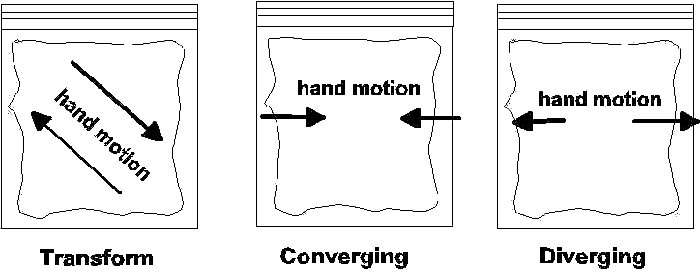BACKGROUND:
As they move, plates interact at their edges or
boundaries. As described in the Pre Lab, in some places two plates move
apart from each other; this is a diverging plate boundary. In other areas,
two plates move together; this is a converging plate boundary. Finally
plates can also slide past each other horizontally. This is called a
transform plate boundary.
Plate movement generates stress in the rocks at plate
boundaries. The type of stress is different at each type of plate boundary.
At converging plate boundaries rocks are squeezed (compression), at
diverging plate boundaries they are stretched (tension or extension), and at
transform boundaries they are pushed past each other (shear). Because the
plates are rigid rock, they resist this motion until they break, creating
earthquakes. The compression at converging plate boundaries also creates
mountains; all of the worlds large mountain ranges formed at this type of
boundary.
This exercise allows the students to experience how
stress on the outer portion on the Earth effects the plates. They will
deform, or stress, "plastic" earth with converging, diverging, and
transforming motions.
PROCEDURE:
-
Explain to the class that plate motion causes stress at plate
boundaries. Remind students of the three ways plates interact:
converging, diverging, and transform motion. You may wish to demonstrate
these motions with your hands.
-
Tell the students that they will be making mountains and valleys in
the same way that plate movements form these features. Be sure to
compare mountains and valleys with the students. Explain that mountains
form at converging plate boundaries, where plates squeeze together, and
valleys are more common where plates move apart, at diverging plate
boundaries. Transform plate boundaries often form a combination of small
mountains and valleys.
-
Have the students make a flour and water mixture. Have them mix 2
parts of flour with 1 part of water in small containers (Cool Whip or
margarine containers work well). They should blend the mix with a spoon
until it becomes pasty. Check the mixture before the students put it
into the plastic bags, making sure that is neither too wet nor too dry.
Have the students pour their mixtures into the plastic bags. Make sure
each baggy is "zipped" tightly or you will end up with a mess
on your hands. If the bags are sealed correctly the mixture will remain
pliable for up to 5 months. You may wish to have the students take the
plastic bags home to demonstrate what they did to their parents.
-
Demonstrate converging, diverging, and transform plate boundary
motions to the students. Have the students stress the bags as shown in
the diagrams below. Tell the students to observe what happens as they
apply each type of stress. Go around to each of the students, making
sure they can point out mountains and valleys. When the students try to
"diverge", they should not apply a lot of pressure because the
paste will not gush up. In a real diverging zone, however, lava fills in
the void.

-
In conclusion, discuss that when the outer portion of the
Earth is under stress, earthquakes take place to relieve the stress.
|